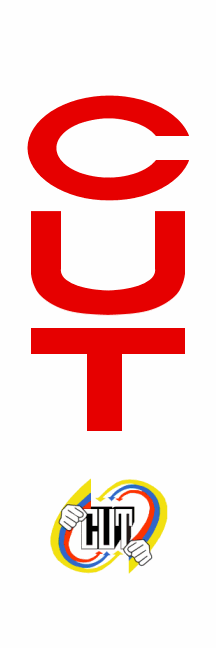
image by Eugene Ipavec, 3 September 2007

Last modified: 2008-07-19 by dov gutterman
Keywords: colombia | trade union |
Links: FOTW homepage |
search |
disclaimer and copyright |
write us |
mirrors
Editorial Remark: It must be noted that all the opinions are of the authors and not of FOTW. Our site is non-political and concentrates only on vexillological issues.
See also:
Aside from the three main national unions existing in
Colombia, there are also other unions wich represent workers from
a particular economic sector, like the USO of
the oil industry.
The other major sector union is FECODE (Federación Colombiana de
Educadores, or Colombian Teachers Federation, official website:
<www.fecode.edu.co>).
It represents teachers nationwide.
There was a time during the 20th century where other sector
unions and company's unions were very important as well, but now
the three main national unions, (CTC, CGT and CUT, and now the
UTRACUN), plus the sectorial USO and FECODE are the main
organizations.
Neither USO or FECODE wanted to merge with any of the national
unions because they still hold much negotiating power alone that
would be lost if they merge with other unions, as happened with
other important unions that merged to form the three main
Centrales Obreras (Workers Centrals), as they are locally called,
in order to refer to them as the main representatives of Clombian
workers.
However there is an estimate, that only 20% of Colombian workers
is represented in these national unions, or Central, also because
private companies also have their own unions, but these workers
would loose benefits if they were to merge into any of these
three main Centrals, because not only these Centrals support
labor rights, but also may support political candidates,
specially leftist candidates, coming mainly from the PDA (Polo Democrático Alternativo, or
Alternative
Democratic Pole), which is the merger of AD and PDI parties.
E.R., 23 February 2008

image by Eugene Ipavec, 3 September 2007
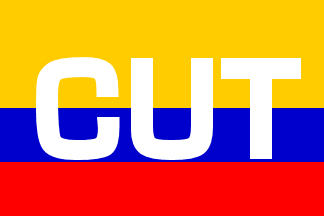
variant
image by Eugene Ipavec (based on original by Jaume
Ollé), 3 September 2007
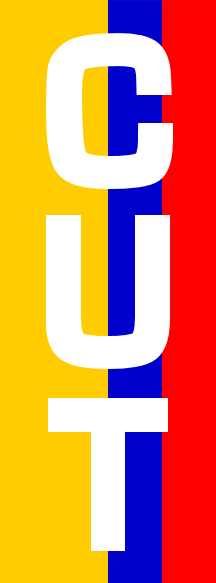
variant
image by Eugene Ipavec (based on original by Jaume
Ollé), 3 September 2007
.gif)
logo
image by Eugene Ipavec, 3 September 2007
Central Unitaria de Trabajdores de Colombia (CUT) is
Colombia's biggest trade union. It's official website is located
at <www.cut.org.co>
where you can see their flag: CUT letters in red, on a white
vertical banner. Their Coat of Arma is seen on the upper right
corner on their homepage. Another variants of the flag was
reported by Jaumé Ollé in 2004.
The CUT was founded on November 15-17, 1986, but it traces back
its roots to 1936. On August 7, 1936 the Confederación de
Trabajadores de Colombia (CTC) (Colombian Workers Confederation)
was established of Liberal and Communist tendencies. It adhered
to the Confederación de Trabajadores de América Latina (CTAL)
(Latin American Workers Confederation (LAWC)) and later on to the
Federación Sindical Mundial (FSM) (World Federation of Trade
Unions (WFTU)). In May 1950 it breaks away from the
Confederación de Trabajadores de América Latina and the
Federación Sindical Mundial by a guideline issued by the Partido Liberal Colombiano and
instead it addheres to the Confederacióin Interamericana de
Trabajadores (CIT) (Interamerican Workers Confederation (IWC).
Aside from the CTC, on June 12, 1946 the Unión de Trabajadores
de Colombia (UTC) (Colombian Workers Union) was established,
based on Christian ideas. On May 1, 1964 the UTC evolves into the
Confederación Sindical de Trabajadores de Colombia (CSTC)
(Colombian Workers Trade Union Confederation). This recently
created orgnization addheres to the Congreso Permanente de Unidad
Sindical de los Trabajdores de América Latina y el Caribe
(CPUSTAL) (Latin American and Caribbean Workers Trade Union
Permanent Congress (LAWTUPC)) and later to the Federación
Sindical Mundial (World Federation of Trade Unions (WFTU))
becoming the foremost trade union in Colombia. Later on April 30,
1971 a dissident group within the UTC forms the Confederación
General del Trabajo (CGT) (Labor General Confederation) with
a Social Democratic-Christian tendency. The CGT
affialietes to the Central Latinoamericana de Trabajadores
(CLAT)(Latin American Workers Central (LAWC)) and to the
Conferencia Mundial del Trabajo (CMT)(World Conference Labour
(WCL)).
Apart from these, other non-confederated trade unions in Colombia
emerge as well, being labeled as Non-Confederated Trade Tnions,
because they were trade unions specifically for a company or
representing an economic sector, some with National importance,
others with State and Local importance. Among them are FENALTRASE
(Transoprtation trade union), FENASINTRAP, FEDEPETROL (Oil
industry trade union), FECODE (Teachers trade union), SITTELECOM
(Telecom, the State's biggest telecommunications company before
being privatized), BANCARIOS (union of banks' trade unions),
gathering public education trade unions, state-owned companies
trade unions, bank trade unions, transportation trade unions,
health industry and hospitals trade unions, oil and energy trade
unions. Then on July 14, 1985, FENALTRASE promotes all
Non-Confederated Trade Unions togather around the CSTC, signed by
the following groups: Usitras, Asicun, , Sintraferrovías,
Sintraicollantas, Fecode, Sintrapopular (which comprised the
union of the following trade unions: Fenaltrase,
Fenasibancol, Fedepetrol, Cusi, Central Sindical Revolucionaria,
Festrac and the Uso). Then the Coordinadora de Unidad Sindical
(CUS) or Trade Union Coordination (TUC) was created, by: CSTC,
Confederated Trade Unions, UTC and CTC, to develop into bigger
trade union. Then finally on November 15-17, 1986, all of the
previously mentioned trade unions (UTC, CSTC, CTC and the
Confederated Trade Unions) merge to form the CUT.
Source: <www.cut.org.co>.
E.R., 3 September 2007
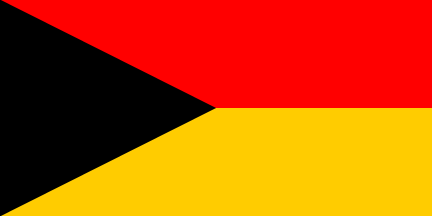
image by Eugene Ipavec., 6 March 2008
.gif)
logo
image by Eugene Ipavec., 6 March 2008
This is another Colombian workers union, called CGT
(Confederación General del Trabajo, General Labor
Confederation). The CGT was called the CGTD
as can be seen on their homepage a picture
of the CGT's National EsecutiveCommittee, in which the logo of
the CGTD is on the background of this meeting.
The CGT official flag can be seen at <www.cgtcolombia.org>.
It has a very similiar pattern comapred to the Czech Republic flag - it has two horizontal
stripes, the color being red (on the top fringe),
symbolizing the blood of the workers spilled during their
struggles, the yellow (on the bottom fringe) is symbolizing the
country's richness in natural resources, and the black (on the
triangle) symbolizing the will of the workers.
The CGT official logo is at <www.cgtcolombia.org>.
It is the three letters of the CGT in red on an anvil with a hand
holding a torch. It is based on the CGTD
logo. CGT official website is at <www.cgtcolombia.org>.
E.R., 6 March 2008
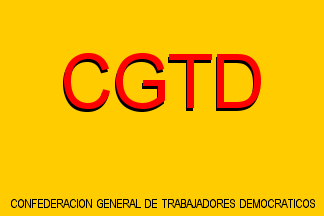
flag
image by Eugene Ipavec (based on original by Jaume
Ollé), 3 September 2007
.jpg)
logo
image contributed by Jaume Ollé

image by Eugene Ipavec (based on original by Jaume
Ollé), 3 September 2007
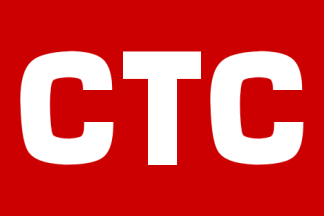
image by Eugene Ipavec (based on original by Jaume
Ollé), 3 September 2007
Founded in 1935.
E.R., 3 September 2007
The CTC has its own official website, at <www.ctc-colombia.com.co>.
The Coat of Arms can also be found on their homepage. For
more on their historical backgrounds, see this page.
E.R., 23 February 2008

image by Eugene Ipavec (based on original by Jaume
Ollé), 3 September 2007

image by Eugene Ipavec (based on original by Jaume
Ollé), 3 September 2007
It is the trade union of the Ecopetrol
company (Empresa Colombiana de Petróleos, Colombian Oil
Company), Colombia's biggest State owned company until 2007 when,
in a procces of privatization starting on August 27 and ending on
September 25, it will sell some of its shares to seek capital on
the market, on different stages onwards.
Jaume Ollé reported in 2004 also on another flag seen
here in a photo.
The USO was officially established in 1937, but it had been
active underground since early 1922. It has its own official
website at <www.usofrenteobrero.org>.
E.R., 3 September 2007

image by Eugene Ipavec., 19 March 2008
There is a new national workers union being set up in
Colombia. It's called UTRACUN (Unión de Trabajadores de Cundinamarca, Cundinamarca Workers Union).
It started as a Union for Cundinamarca workers. It was
established on April 30, 1951, lobbying for better wages, social
security coverage among other requests. It is new in terms of
nationwide operation. At first it was mainly a regional union.
However it expanded up to the point that it currently has
national representation. It is in favor of free market practices
and supports close relations between employers and employees, as
well, as free trade agreements among countries, and other free
market practices. In this views, it opposes the other three
big national nationwide unions, CGT, CTC and CUT.
It encompasses in total 66 unions from textiles, flowers,
beverages, food, plastic, metalmechanics, and minning
companies, from Antioquia, Caldas, Cundinamarca, Risaralda and
Valle, with over 45,000 affiliates.
The flag of the Union can be seen in article
at El Tiempo newspaper. The flag is a red over white, horizontal
flag, with the Coat of Arms of the Department of Cundinamarca in
the middle, surrounded by a half gray cogwill on the
right and a halg yellow laurel wreath on the
left.
UTRACUN official website is at <www.utracun.com.co>.
E.R., 19 March 2008